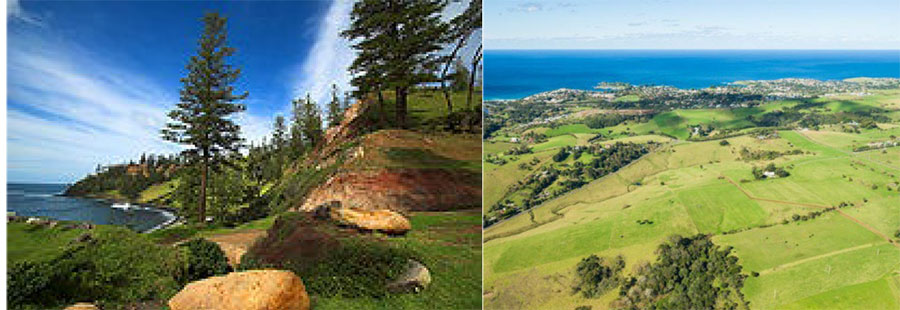Life on the West Island - Seaside sisters

18 June 2024
This week, Life on the West Island attended an interesting presentation about Norfolk Island, hosted by U3A (the University of the Third Age). Many of those attending indicated by a show of hands that they had visited Norfolk Island, some on a number of occasions. Naturally there was much talk about Norfolk Island language and culture, the Island’s natural beauty and its vibrant community. Attendees highlighted fish fries, garden tours, museums and history, progressive dinners and the warm welcomes they received from Norfolk Islanders, among many other memories.
What struck us most was the number of parallels between communities on the south coast of the Premier State and Norfolk Island. For example, let’s consider the similarities between the seaside area around Kiama (about 120 km south of Sydney) and Norfolk Island.
Although Kiama is being transformed by the large number of “sea changers” choosing to relocate there away from the frenetic life of the city, it remains in the heart of rich dairying country, reminiscent of Norfolk. The cows which graze the rolling green hills and valleys beyond the town might be mainly farmed for milk, but the landscapes are strikingly similar. When standing at the Mount Saddleback lookout, you could be excused for straining your eyes at the horizon, expecting to see Phillip Island rising majestically out of the sea, behind a foreground of cattle grazing languidly among the Norfolk Island pines and cabbage tree palms.
And that’s another distinct similarity. The Kiama area has hundreds of large mature Norfolk Island pines, many of them well over a century old. Some locals think that these magnificent trees are native to the West Island, but in fact the species araucaria heterophylla is endemic to Norfolk Island, where 13 different varieties may be found. Early colonists brought seeds and saplings to the West Island, where they have become emblematic of hundreds of beachside towns. Kiama is no exception, boasting esplanades of Norfolk Island pines, which also flank the showground, the cemetery, the golf course and the foreshores.
As in Norfolk Island, nobody in Kiama lives far from a magnificent white sand beach, where both swimming and surfing are well catered for. Each location also has a volcanic history, with clear remnants of past lava flows and plenty of basalt stacks. (Kiama was both a major port and the source of much of the crushed basalt used for road construction in Sydney for over a century.) Both locations have steep rugged cliffs and rock formations of interest to both geologists and tourists. Kiama even has its own Cathedral Rock, although in pales in size compared with the towering sea stack of the same name off the north coast of Norfolk Island.
Then there is the fishing! For many years, residents of Kiama and Norfolkers have exchanged visits to each other’s legendary offshore recreational fishing areas, probably accompanied by tall tales of the ones that got away. Fishing is a way of life for many in both locations, although in our experience the tasty barbecued schnapper and flathead of the mainland do not hold a candle to a delectable fish fry of Norfolk trumpeter or kingfish! In both places, the fish is generally freshly caught, not the frozen flake or soggy farmed barramundi served at less favoured West Island locations.
Life on the West Island has previously written about the enjoyable agricultural shows in the two locations, which in many ways are mirror images of each other, with ring events and spectacular displays of fresh produce and all types of cooking, gardening, arts and crafts. Both places have held annual shows of this type for well over a century at times of harvest, when the whole community comes together with pride to celebrate its productivity and skill.
This brings us to the focus on creativity and artistic talent of both Norfolk and Kiama. Each has numerous festivals and venues celebrating a wide range of creative endeavour, including (but not limited to) painting; a wide variety of live music from folk to country to rock to classical and many more genres; ceramics and pottery; glassworking; knitting, embroidery, crochet and quilting; to name just a few. And both have a strong tradition of creative writing and poetry, not to mention dozens of published books and pamphlets on local history. Norfolk has many celebrated historians and novelists, while Kiama claims as its own Charmian Clift, acclaimed author, columnist and feminist, whose life was recently marked with a blue plaque mounted outside its excellent public library. Both places also have excellent small museums and galleries, highlighting local history and significant achievements.
Another similarity is the native forests and bushland which flourish in close proximity to where people live. Norfolk Island has its magnificent national park which dominates the landscape on the slopes of Mount Pitt and other delightful areas such as Hundred Acre Reserve and Walk in the Wild. Kiama is close to the forested areas of the eastern side of the coastal escarpment, including Minnamurra Rainforest, Jerrara Arboretum and Wetlands and the Barren Grounds native wildflower and waterfall reserve.
With so many similarities, it is not surprising that many Kiama residents have chosen to visit or live in Norfolk Island and vice versa. They find the people, culture and landscapes familiar and welcoming. Perhaps the two communities could even be regarded as “seaside sisters.”